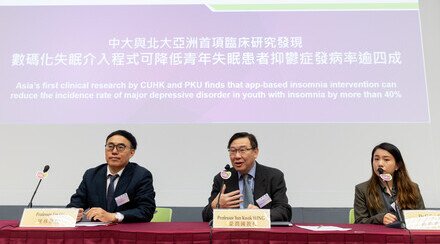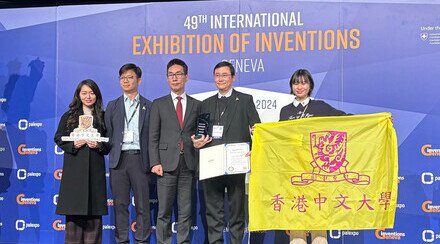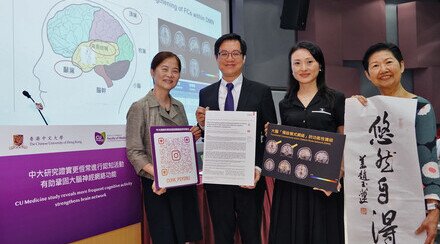CUHK-HKU Study Proves Bright Light Therapy as an Adjunctive Treatment Improves Outcomes in Depressed “Night Owl” Patients
A collaborative study by the Department of Psychiatry at CU Medicine and the Department of Psychology of the Faculty of Social Sciences at HKU proved adjunctive bright light therapy is effective for “night owls" with depression, doubling the probability of achieving remission. (From left) Dr. Shirley Li, Assistant Professor of the Department of Psychology, Faculty of Social Sciences at HKU; Professor Yun Kwok WING, Chairman and Dr. Joey Wing Yan CHAN, Associate Professor of the Department of Psychiatry at CU Medicine.
Depression is among the most common mental health problems. About 1 in 10 adults in Hong Kong suffer from depressive symptoms. There is growing research suggesting a close relationship between mood disorders and the biological clock. “Night owls”, refers those who are late to bed and late to rise, are at greater risk of poor clinical outcomes with more sleep disturbances and depressive symptoms. The Department of Psychiatry of the Faculty of Medicine at The Chinese University of Hong Kong (CU Medicine), in collaboration with the Department of Psychology of the Faculty of Social Sciences at the University of Hong Kong (HKU), have conducted the world's first randomised controlled trial of adjunctive bright light therapy for “night owls” with depression. Results showed bright light therapy doubles the probability of achieving remission, and the cumulative remission rate of depression reaches 67.4%.
20% of patients with depression are “night owls”
Circadian rhythm (known as the biological clock) does not only influence our sleep, but also our mood, cognitive performance, and many physiological and endocrine functions. Upsurging research suggests a close relationship between circadian rhythm and mood disorders. According to individual circadian preference, that is to say one’s preferred time for rest and activity, people can be classified into morning-type (commonly known as “morning lark”), intermediate-type and evening-type (often being known as “night owls”).
Dr. Joey Wing Yan CHAN, Associate Professor from the Department of Psychiatry, CU Medicine said, “In our previous work on a cohort of patients with depression from the psychiatric specialist out-patient clinic, about 20% of patients were classified as ‘night owls’. They were more likely to have worse clinical outcomes with more sleep disturbances and depressive symptoms, along with higher suicidality and non-remission of depression despite receiving conventional psychiatric treatment.”
Professor Yun Kwok WING, Chairman of the Department of Psychiatry, CU Medicine said, “Depression is a very common mental health problem with detrimental consequences. We are among the first group of researchers suggesting the important influences of circadian preference on the clinical outcome of depression, especially for the evening-type circadian preference. Our team strives to develop effective and novel treatments that could improve the clinical outcomes of the patients with depression. There has been increasing evidence suggesting the therapeutic effects of bright light treatment for both circadian related disorders and depression.”
Professor Yun Kwok WING says circadian rhythm influences body functions, including mental health. Light is an important circadian cue to synchronise internal biological clock with the external environment.
Bright light therapy helps regulate biological clock
Bright light therapy is a way to treat depression by exposure to artificial light. During the light therapy, patient sits or works near a device called a light therapy box. The box gives off bright light that mimics natural outdoor light.
Dr. Shirley LI, Assistant Professor from the Department of Psychology, Faculty of Social Sciences at HKU, explained, “Light is an important cue to synchronise our internal biological clock with the external environment. A properly timed bright light therapy is useful in reducing the circadian misalignment for depression patients with evening tendency. The mechanism behind the improvement may link to the modulation of serotonin balance in the brain that plays an important part in our emotional well-being.”
Dr. Shirley LI says sleep deprivation, poor sleep quality, higher risk for psychopathology are associated with evening chronotype.
Dr. Joey Wing Yan CHAN (right) explains that this bright light therapy gives off bright light that mimics natural outdoor light, helping patients with depression to regulate circadian rhythm and thus relieving depressive symptoms.
Bright light therapy doubles the probability of achieving remission
Bright light therapy has been suggested as an effective treatment for seasonal affective disorder and recently for non-seasonal depression. This joint study conducted by the Department of Psychiatry of the CU Medicine and the Department of Psychology, Faculty of Social Sciences of HKU, is the world's first randomised controlled trial of adjunctive bright light therapy with a gradual advance protocol for patients with both depression and evening-type circadian preference.
The research team invited 93 middle-aged patients (mean age of 46 years, 80% female) during 2015 to 2018 to join the trial. Their habitual bedtimes were around 2 a.m., and rise times around 10:30 a.m.. The patients were divided into an intervention group and a control group. In the intervention group, patients received bright light therapy for 30 minutes a day at home for five weeks, delivered via a light box. The start time of the bright light therapy was gradually advanced over the five-week treatment period. The control group was allocated to receive five weeks of dimmer light with the same advancement protocol. All patients were subsequently followed up for five months after the treatment. The results were published in the international medical journal Psychological Medicine. Below are the key findings:
| Bright light therapy group (47 individuals) | Control group (46 individuals) | |
|---|---|---|
Cumulative remission rate | 67.4% | 46.7% |
| Time to remission | Shorter | Longer |
| Improvement in depressive symptoms | Greater | Less |
The research team also observed that the patients’ sleep pattern changed to earlier bedtimes and rise times upon receiving the treatment. In addition, bright light therapy was well tolerated with fewer side effects from treatment when compared to those of the control group.
Dr. Joey WY CHAN, the investigator of this study remarked, “Our participants had a mean duration of illness for 13.7 years, yet their depression was not well managed by the conventional psychiatric treatment. This study showed that the 5-week bright light therapy with gradual advancement in start time produced a more rapid and higher cumulative rate of remission than the control group, and doubled the probability of achieving remission. In addition, bright light therapy did not induce adverse side effects or interaction which are often associated with psychotropic medications. Thus, bright light therapy is a promising treatment especially for patients who could not tolerate psychotropic medication or in whom psychotropic medications are contraindicated. This study provides a new piece of evidence that bright light therapy could be an effective adjunct treatment in patients with depression and should be more widely used in clinical practice.”
Professor Yun-Kwok WING concluded, “Bright light therapy has its unique therapeutic features in regularising the circadian rhythm and improving mood and sleep. This study shows that using properly timed bright light as a non-pharmacological intervention has an important place in the treatment of depression. It is also useful in advancing the sleep schedule in the group of patients with evening tendency. The research findings are very encouraging, and we are looking forward to further exploring the application of bright light therapy and other circadian related chronotherapeutic measures (such as medications, advance protocol) in different psychiatric disorders and specific patient groups.”
Ms. CHENG (centre) had suffered from depression and insomnia for over 20 years. Sometimes she couldn’t fall into sleep even after having sleeping pills. She says bright light therapy helped resolve her sleeping problem and improve her mood.























